A Comprehensive Report on Workplace Safety and Health Practice
VerifiedAdded on 2023/06/05
|11
|2344
|421
Report
AI Summary
This report provides a detailed overview of workplace safety and health (WSH) practices, focusing on key regulations and principles. It addresses the importance of legal safeguards against excessive noise in the workplace, the duties of company officers in ensuring health and safety, and the responsibilities of employers, manufacturers, and suppliers in maintaining a safe working environment. The report also covers incident reporting procedures, requirements for tunneling and excavation works in Singapore, and the guiding principles of WSH regulations, including risk reduction, ownership, and penalties for poor safety management. Furthermore, it explains the concept of 'reasonably practicable' measures for ensuring workplace safety and includes examples of their implementation.
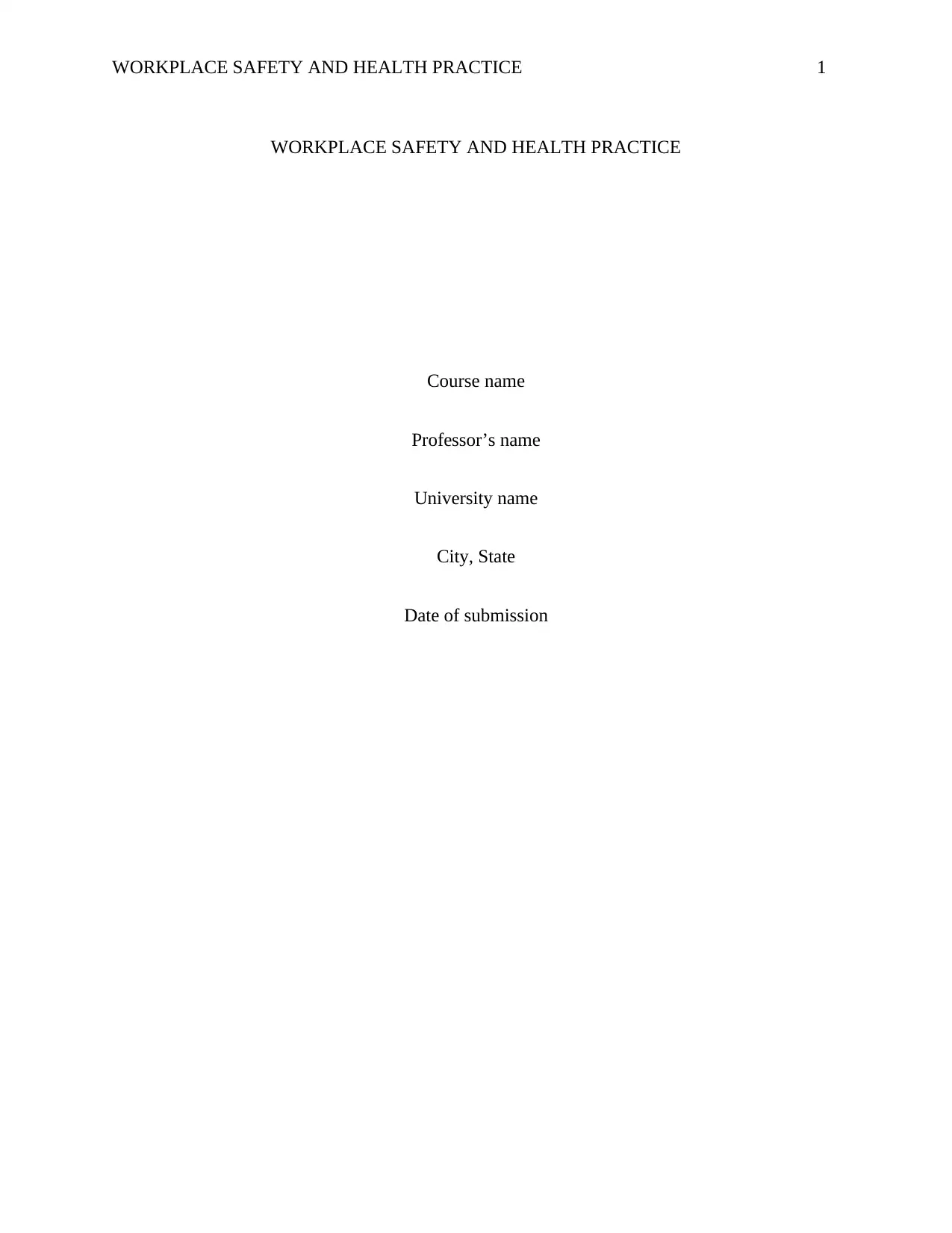
WORKPLACE SAFETY AND HEALTH PRACTICE 1
WORKPLACE SAFETY AND HEALTH PRACTICE
Course name
Professor’s name
University name
City, State
Date of submission
WORKPLACE SAFETY AND HEALTH PRACTICE
Course name
Professor’s name
University name
City, State
Date of submission
Paraphrase This Document
Need a fresh take? Get an instant paraphrase of this document with our AI Paraphraser
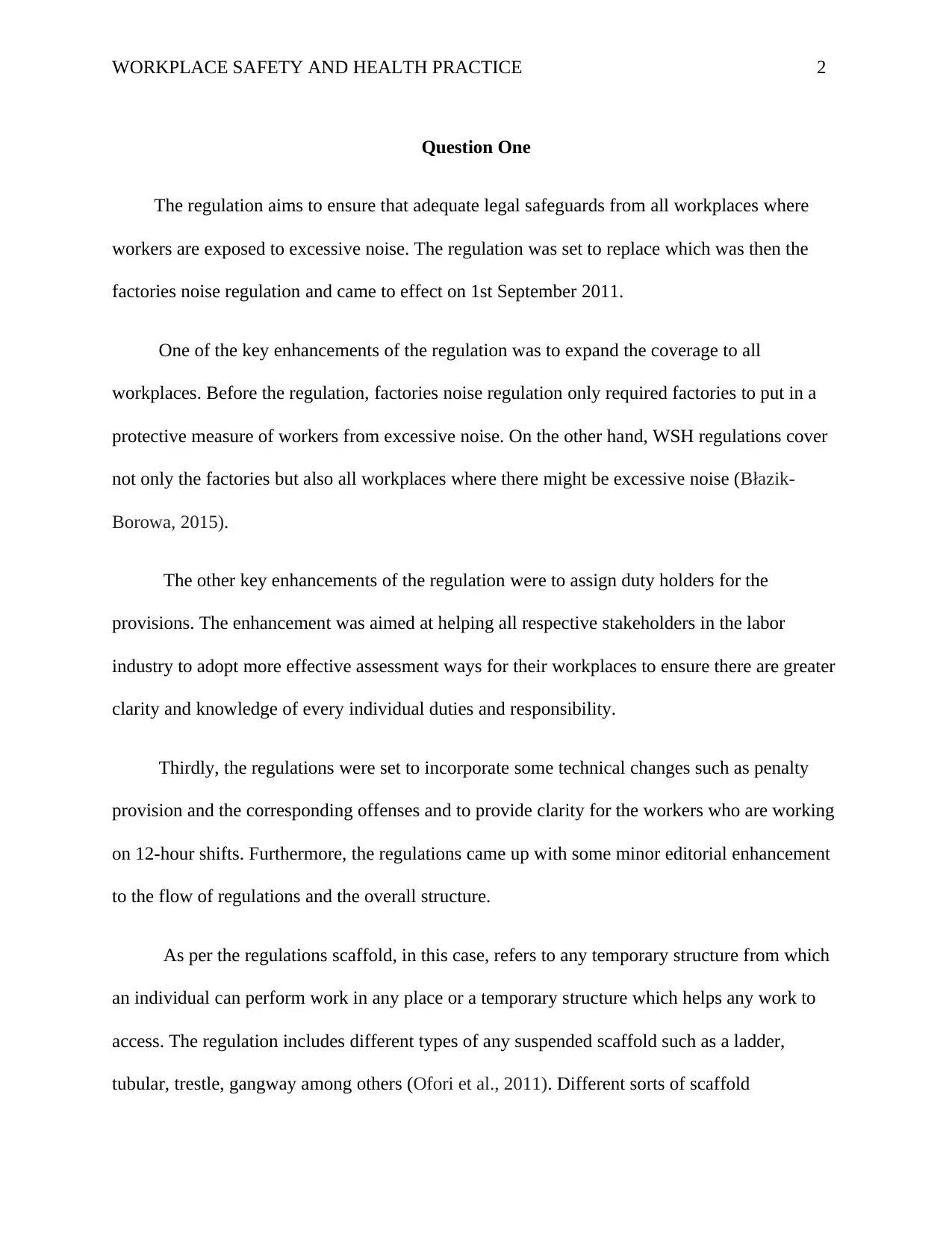
WORKPLACE SAFETY AND HEALTH PRACTICE 2
Question One
The regulation aims to ensure that adequate legal safeguards from all workplaces where
workers are exposed to excessive noise. The regulation was set to replace which was then the
factories noise regulation and came to effect on 1st September 2011.
One of the key enhancements of the regulation was to expand the coverage to all
workplaces. Before the regulation, factories noise regulation only required factories to put in a
protective measure of workers from excessive noise. On the other hand, WSH regulations cover
not only the factories but also all workplaces where there might be excessive noise (Błazik-
Borowa, 2015).
The other key enhancements of the regulation were to assign duty holders for the
provisions. The enhancement was aimed at helping all respective stakeholders in the labor
industry to adopt more effective assessment ways for their workplaces to ensure there are greater
clarity and knowledge of every individual duties and responsibility.
Thirdly, the regulations were set to incorporate some technical changes such as penalty
provision and the corresponding offenses and to provide clarity for the workers who are working
on 12-hour shifts. Furthermore, the regulations came up with some minor editorial enhancement
to the flow of regulations and the overall structure.
As per the regulations scaffold, in this case, refers to any temporary structure from which
an individual can perform work in any place or a temporary structure which helps any work to
access. The regulation includes different types of any suspended scaffold such as a ladder,
tubular, trestle, gangway among others (Ofori et al., 2011). Different sorts of scaffold
Question One
The regulation aims to ensure that adequate legal safeguards from all workplaces where
workers are exposed to excessive noise. The regulation was set to replace which was then the
factories noise regulation and came to effect on 1st September 2011.
One of the key enhancements of the regulation was to expand the coverage to all
workplaces. Before the regulation, factories noise regulation only required factories to put in a
protective measure of workers from excessive noise. On the other hand, WSH regulations cover
not only the factories but also all workplaces where there might be excessive noise (Błazik-
Borowa, 2015).
The other key enhancements of the regulation were to assign duty holders for the
provisions. The enhancement was aimed at helping all respective stakeholders in the labor
industry to adopt more effective assessment ways for their workplaces to ensure there are greater
clarity and knowledge of every individual duties and responsibility.
Thirdly, the regulations were set to incorporate some technical changes such as penalty
provision and the corresponding offenses and to provide clarity for the workers who are working
on 12-hour shifts. Furthermore, the regulations came up with some minor editorial enhancement
to the flow of regulations and the overall structure.
As per the regulations scaffold, in this case, refers to any temporary structure from which
an individual can perform work in any place or a temporary structure which helps any work to
access. The regulation includes different types of any suspended scaffold such as a ladder,
tubular, trestle, gangway among others (Ofori et al., 2011). Different sorts of scaffold
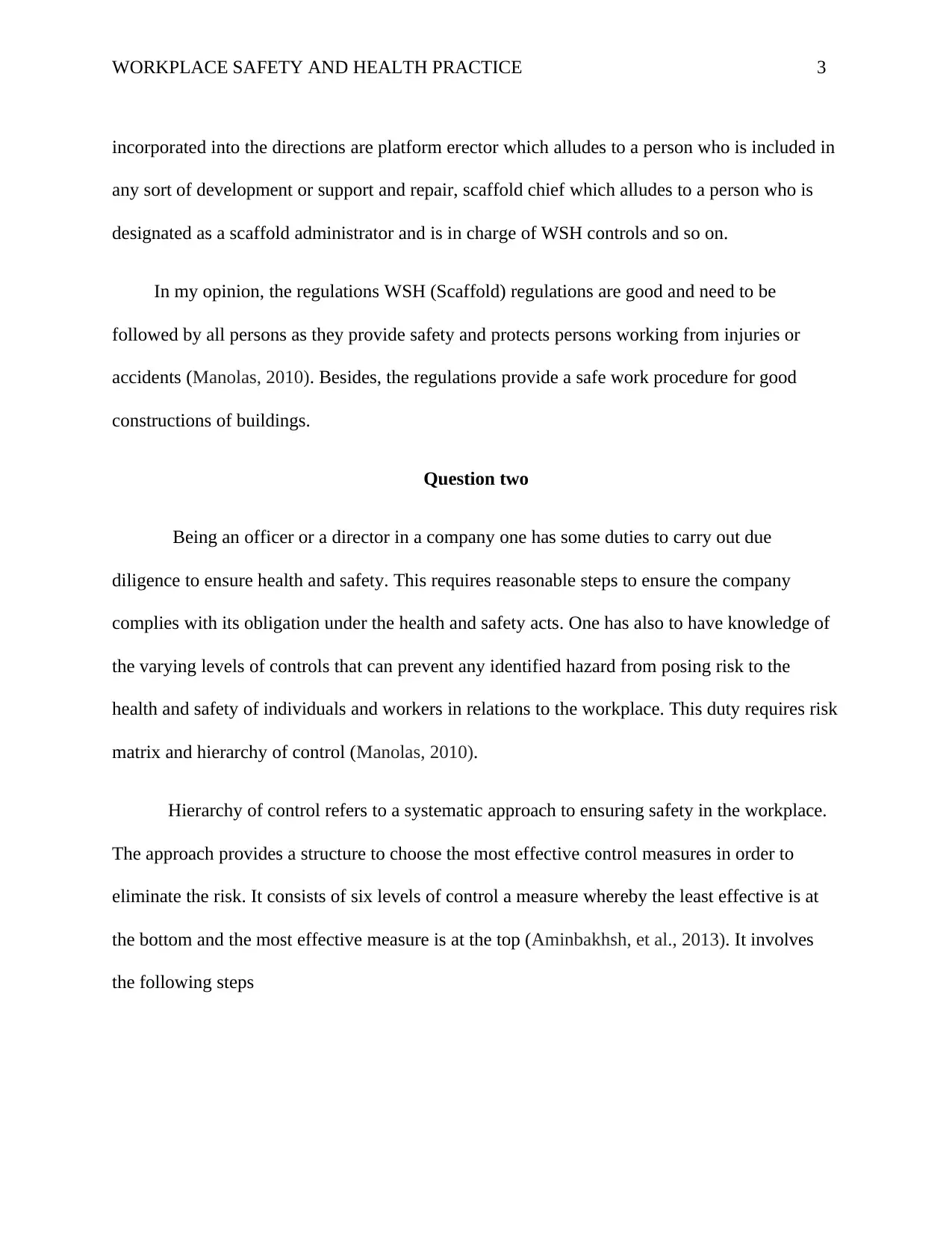
WORKPLACE SAFETY AND HEALTH PRACTICE 3
incorporated into the directions are platform erector which alludes to a person who is included in
any sort of development or support and repair, scaffold chief which alludes to a person who is
designated as a scaffold administrator and is in charge of WSH controls and so on.
In my opinion, the regulations WSH (Scaffold) regulations are good and need to be
followed by all persons as they provide safety and protects persons working from injuries or
accidents (Manolas, 2010). Besides, the regulations provide a safe work procedure for good
constructions of buildings.
Question two
Being an officer or a director in a company one has some duties to carry out due
diligence to ensure health and safety. This requires reasonable steps to ensure the company
complies with its obligation under the health and safety acts. One has also to have knowledge of
the varying levels of controls that can prevent any identified hazard from posing risk to the
health and safety of individuals and workers in relations to the workplace. This duty requires risk
matrix and hierarchy of control (Manolas, 2010).
Hierarchy of control refers to a systematic approach to ensuring safety in the workplace.
The approach provides a structure to choose the most effective control measures in order to
eliminate the risk. It consists of six levels of control a measure whereby the least effective is at
the bottom and the most effective measure is at the top (Aminbakhsh, et al., 2013). It involves
the following steps
incorporated into the directions are platform erector which alludes to a person who is included in
any sort of development or support and repair, scaffold chief which alludes to a person who is
designated as a scaffold administrator and is in charge of WSH controls and so on.
In my opinion, the regulations WSH (Scaffold) regulations are good and need to be
followed by all persons as they provide safety and protects persons working from injuries or
accidents (Manolas, 2010). Besides, the regulations provide a safe work procedure for good
constructions of buildings.
Question two
Being an officer or a director in a company one has some duties to carry out due
diligence to ensure health and safety. This requires reasonable steps to ensure the company
complies with its obligation under the health and safety acts. One has also to have knowledge of
the varying levels of controls that can prevent any identified hazard from posing risk to the
health and safety of individuals and workers in relations to the workplace. This duty requires risk
matrix and hierarchy of control (Manolas, 2010).
Hierarchy of control refers to a systematic approach to ensuring safety in the workplace.
The approach provides a structure to choose the most effective control measures in order to
eliminate the risk. It consists of six levels of control a measure whereby the least effective is at
the bottom and the most effective measure is at the top (Aminbakhsh, et al., 2013). It involves
the following steps
⊘ This is a preview!⊘
Do you want full access?
Subscribe today to unlock all pages.

Trusted by 1+ million students worldwide
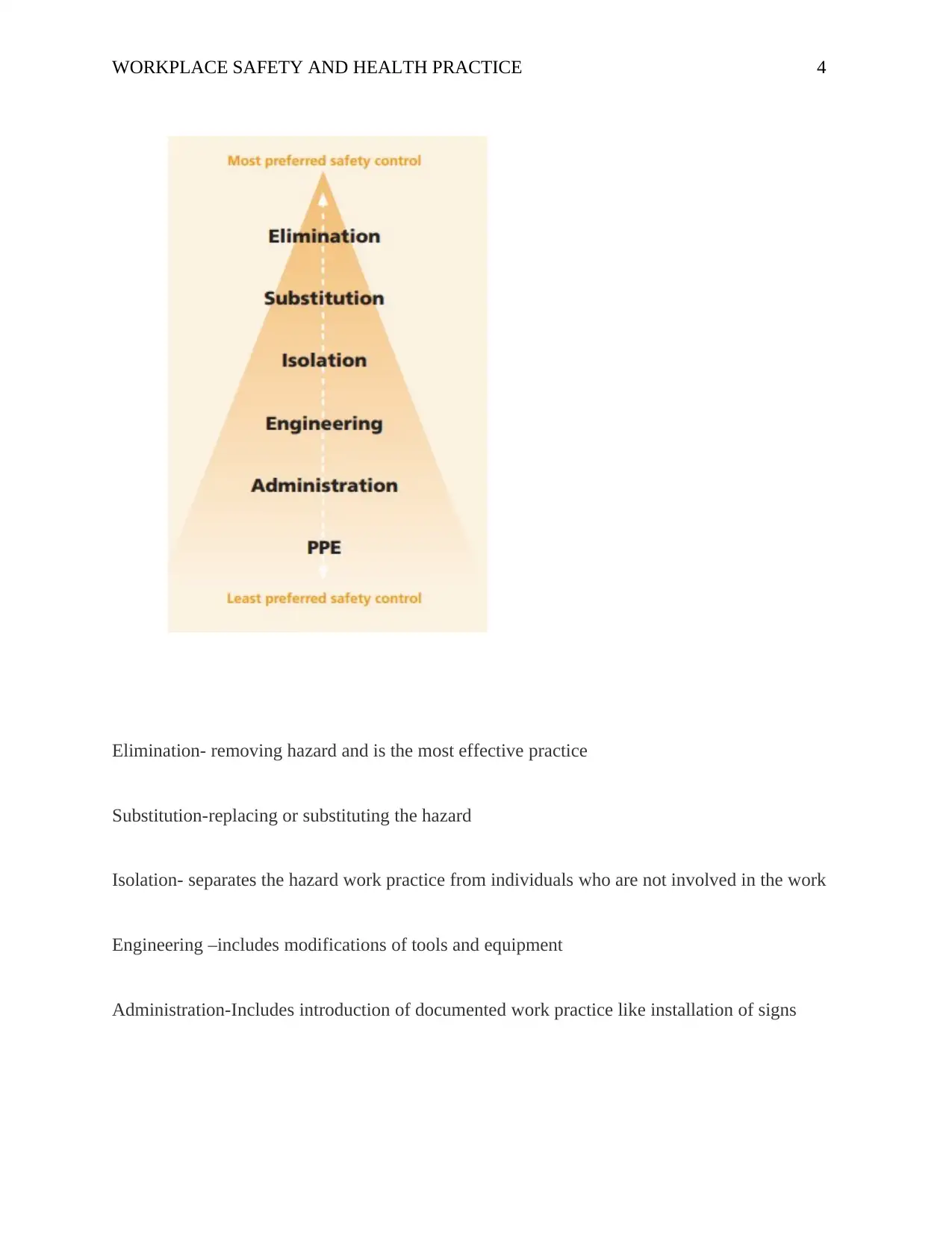
WORKPLACE SAFETY AND HEALTH PRACTICE 4
Elimination- removing hazard and is the most effective practice
Substitution-replacing or substituting the hazard
Isolation- separates the hazard work practice from individuals who are not involved in the work
Engineering –includes modifications of tools and equipment
Administration-Includes introduction of documented work practice like installation of signs
Elimination- removing hazard and is the most effective practice
Substitution-replacing or substituting the hazard
Isolation- separates the hazard work practice from individuals who are not involved in the work
Engineering –includes modifications of tools and equipment
Administration-Includes introduction of documented work practice like installation of signs
Paraphrase This Document
Need a fresh take? Get an instant paraphrase of this document with our AI Paraphraser

WORKPLACE SAFETY AND HEALTH PRACTICE 5
PPE- Least preferred option and is mostly considered when other control measures and requires
workers to wear PPE such as earplugs and goggles.
Risk assessment matrix
It helps one to be able to consider what can go wrong, determines how bad the outcome can be,
determines how likely is it to happen and calculates the risk level.
PPE- Least preferred option and is mostly considered when other control measures and requires
workers to wear PPE such as earplugs and goggles.
Risk assessment matrix
It helps one to be able to consider what can go wrong, determines how bad the outcome can be,
determines how likely is it to happen and calculates the risk level.
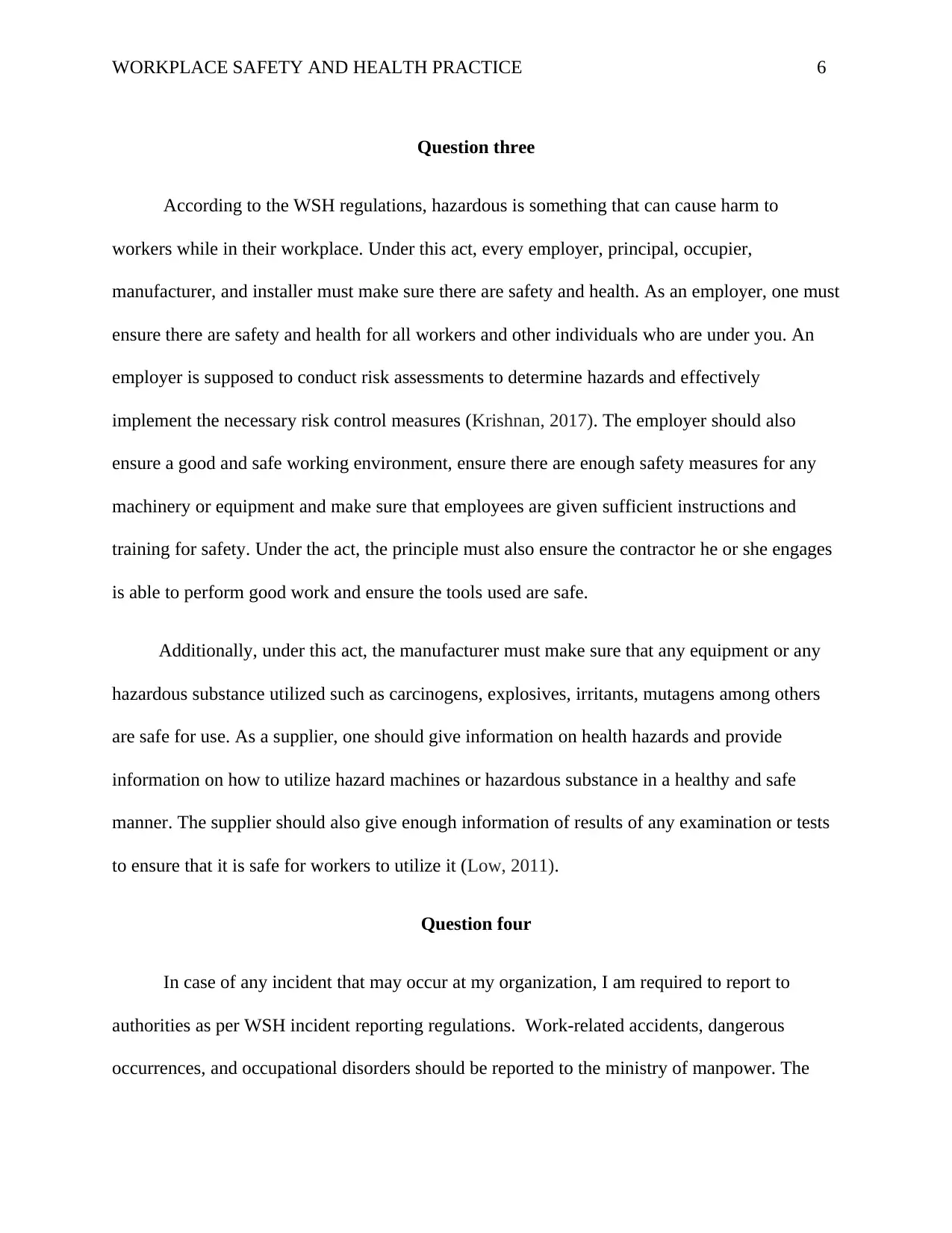
WORKPLACE SAFETY AND HEALTH PRACTICE 6
Question three
According to the WSH regulations, hazardous is something that can cause harm to
workers while in their workplace. Under this act, every employer, principal, occupier,
manufacturer, and installer must make sure there are safety and health. As an employer, one must
ensure there are safety and health for all workers and other individuals who are under you. An
employer is supposed to conduct risk assessments to determine hazards and effectively
implement the necessary risk control measures (Krishnan, 2017). The employer should also
ensure a good and safe working environment, ensure there are enough safety measures for any
machinery or equipment and make sure that employees are given sufficient instructions and
training for safety. Under the act, the principle must also ensure the contractor he or she engages
is able to perform good work and ensure the tools used are safe.
Additionally, under this act, the manufacturer must make sure that any equipment or any
hazardous substance utilized such as carcinogens, explosives, irritants, mutagens among others
are safe for use. As a supplier, one should give information on health hazards and provide
information on how to utilize hazard machines or hazardous substance in a healthy and safe
manner. The supplier should also give enough information of results of any examination or tests
to ensure that it is safe for workers to utilize it (Low, 2011).
Question four
In case of any incident that may occur at my organization, I am required to report to
authorities as per WSH incident reporting regulations. Work-related accidents, dangerous
occurrences, and occupational disorders should be reported to the ministry of manpower. The
Question three
According to the WSH regulations, hazardous is something that can cause harm to
workers while in their workplace. Under this act, every employer, principal, occupier,
manufacturer, and installer must make sure there are safety and health. As an employer, one must
ensure there are safety and health for all workers and other individuals who are under you. An
employer is supposed to conduct risk assessments to determine hazards and effectively
implement the necessary risk control measures (Krishnan, 2017). The employer should also
ensure a good and safe working environment, ensure there are enough safety measures for any
machinery or equipment and make sure that employees are given sufficient instructions and
training for safety. Under the act, the principle must also ensure the contractor he or she engages
is able to perform good work and ensure the tools used are safe.
Additionally, under this act, the manufacturer must make sure that any equipment or any
hazardous substance utilized such as carcinogens, explosives, irritants, mutagens among others
are safe for use. As a supplier, one should give information on health hazards and provide
information on how to utilize hazard machines or hazardous substance in a healthy and safe
manner. The supplier should also give enough information of results of any examination or tests
to ensure that it is safe for workers to utilize it (Low, 2011).
Question four
In case of any incident that may occur at my organization, I am required to report to
authorities as per WSH incident reporting regulations. Work-related accidents, dangerous
occurrences, and occupational disorders should be reported to the ministry of manpower. The
⊘ This is a preview!⊘
Do you want full access?
Subscribe today to unlock all pages.

Trusted by 1+ million students worldwide
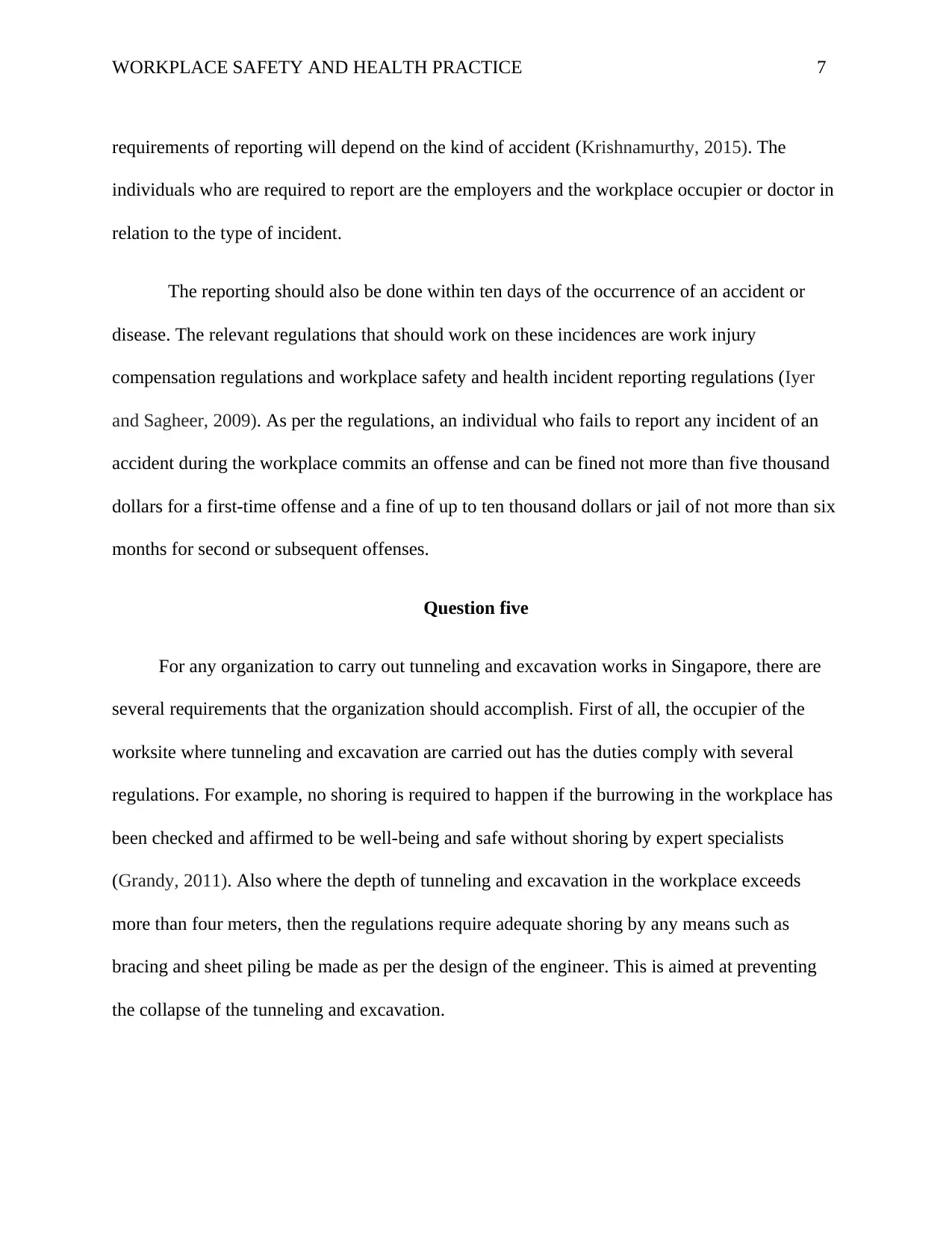
WORKPLACE SAFETY AND HEALTH PRACTICE 7
requirements of reporting will depend on the kind of accident (Krishnamurthy, 2015). The
individuals who are required to report are the employers and the workplace occupier or doctor in
relation to the type of incident.
The reporting should also be done within ten days of the occurrence of an accident or
disease. The relevant regulations that should work on these incidences are work injury
compensation regulations and workplace safety and health incident reporting regulations (Iyer
and Sagheer, 2009). As per the regulations, an individual who fails to report any incident of an
accident during the workplace commits an offense and can be fined not more than five thousand
dollars for a first-time offense and a fine of up to ten thousand dollars or jail of not more than six
months for second or subsequent offenses.
Question five
For any organization to carry out tunneling and excavation works in Singapore, there are
several requirements that the organization should accomplish. First of all, the occupier of the
worksite where tunneling and excavation are carried out has the duties comply with several
regulations. For example, no shoring is required to happen if the burrowing in the workplace has
been checked and affirmed to be well-being and safe without shoring by expert specialists
(Grandy, 2011). Also where the depth of tunneling and excavation in the workplace exceeds
more than four meters, then the regulations require adequate shoring by any means such as
bracing and sheet piling be made as per the design of the engineer. This is aimed at preventing
the collapse of the tunneling and excavation.
requirements of reporting will depend on the kind of accident (Krishnamurthy, 2015). The
individuals who are required to report are the employers and the workplace occupier or doctor in
relation to the type of incident.
The reporting should also be done within ten days of the occurrence of an accident or
disease. The relevant regulations that should work on these incidences are work injury
compensation regulations and workplace safety and health incident reporting regulations (Iyer
and Sagheer, 2009). As per the regulations, an individual who fails to report any incident of an
accident during the workplace commits an offense and can be fined not more than five thousand
dollars for a first-time offense and a fine of up to ten thousand dollars or jail of not more than six
months for second or subsequent offenses.
Question five
For any organization to carry out tunneling and excavation works in Singapore, there are
several requirements that the organization should accomplish. First of all, the occupier of the
worksite where tunneling and excavation are carried out has the duties comply with several
regulations. For example, no shoring is required to happen if the burrowing in the workplace has
been checked and affirmed to be well-being and safe without shoring by expert specialists
(Grandy, 2011). Also where the depth of tunneling and excavation in the workplace exceeds
more than four meters, then the regulations require adequate shoring by any means such as
bracing and sheet piling be made as per the design of the engineer. This is aimed at preventing
the collapse of the tunneling and excavation.
Paraphrase This Document
Need a fresh take? Get an instant paraphrase of this document with our AI Paraphraser

WORKPLACE SAFETY AND HEALTH PRACTICE 8
Also, if the depth of the tunneling in the workplace exceeds more than four meters, the
regulations require no tunneling and excavation or shoring can take place until when one is
issued with the certificate which is issued in relation to the bracing, piling shoring for that
tunneling. Furthermore, during any tunneling and excavation work in the workplace, all
reasonable measures of safety shall be ensured in order to prevent an individual from being
trapped, prevent any individual from being struck by an object or machine, any worker from
falling and to prevent any employee from inhaling impurities of air excavation such as carbon
monoxide (Manolas, 2010).
It is also the responsibility of the designated individual to take reasonably practicable
measures that are required to make sure that any inspection that is carried out is conducted
professionally, fairly and properly. If in case the designated individual fails to take reasonably
practicable measures for proper inspection, then he or she will be guilty of an offense and if
convicted he or she will be fined a fine of not more than two thousand dollars (Hwang, 2013).
Question six
WSH regulations are an important part of a framework to ensure good safety for all people
while in the workplace. The legislation needs every person to take part in a reasonably
practicable measure in order to make sure the safety and health of every person in the workplace
are guarded.
The regulations have three guiding principles which includes; reduction of risk at the
source- the principle seeks to minimize the risk to hazard by requiring all individuals involved in
the workplace to limit the risk they create (Tan, et al., 2013). The second principle of the act is to
Also, if the depth of the tunneling in the workplace exceeds more than four meters, the
regulations require no tunneling and excavation or shoring can take place until when one is
issued with the certificate which is issued in relation to the bracing, piling shoring for that
tunneling. Furthermore, during any tunneling and excavation work in the workplace, all
reasonable measures of safety shall be ensured in order to prevent an individual from being
trapped, prevent any individual from being struck by an object or machine, any worker from
falling and to prevent any employee from inhaling impurities of air excavation such as carbon
monoxide (Manolas, 2010).
It is also the responsibility of the designated individual to take reasonably practicable
measures that are required to make sure that any inspection that is carried out is conducted
professionally, fairly and properly. If in case the designated individual fails to take reasonably
practicable measures for proper inspection, then he or she will be guilty of an offense and if
convicted he or she will be fined a fine of not more than two thousand dollars (Hwang, 2013).
Question six
WSH regulations are an important part of a framework to ensure good safety for all people
while in the workplace. The legislation needs every person to take part in a reasonably
practicable measure in order to make sure the safety and health of every person in the workplace
are guarded.
The regulations have three guiding principles which includes; reduction of risk at the
source- the principle seeks to minimize the risk to hazard by requiring all individuals involved in
the workplace to limit the risk they create (Tan, et al., 2013). The second principle of the act is to
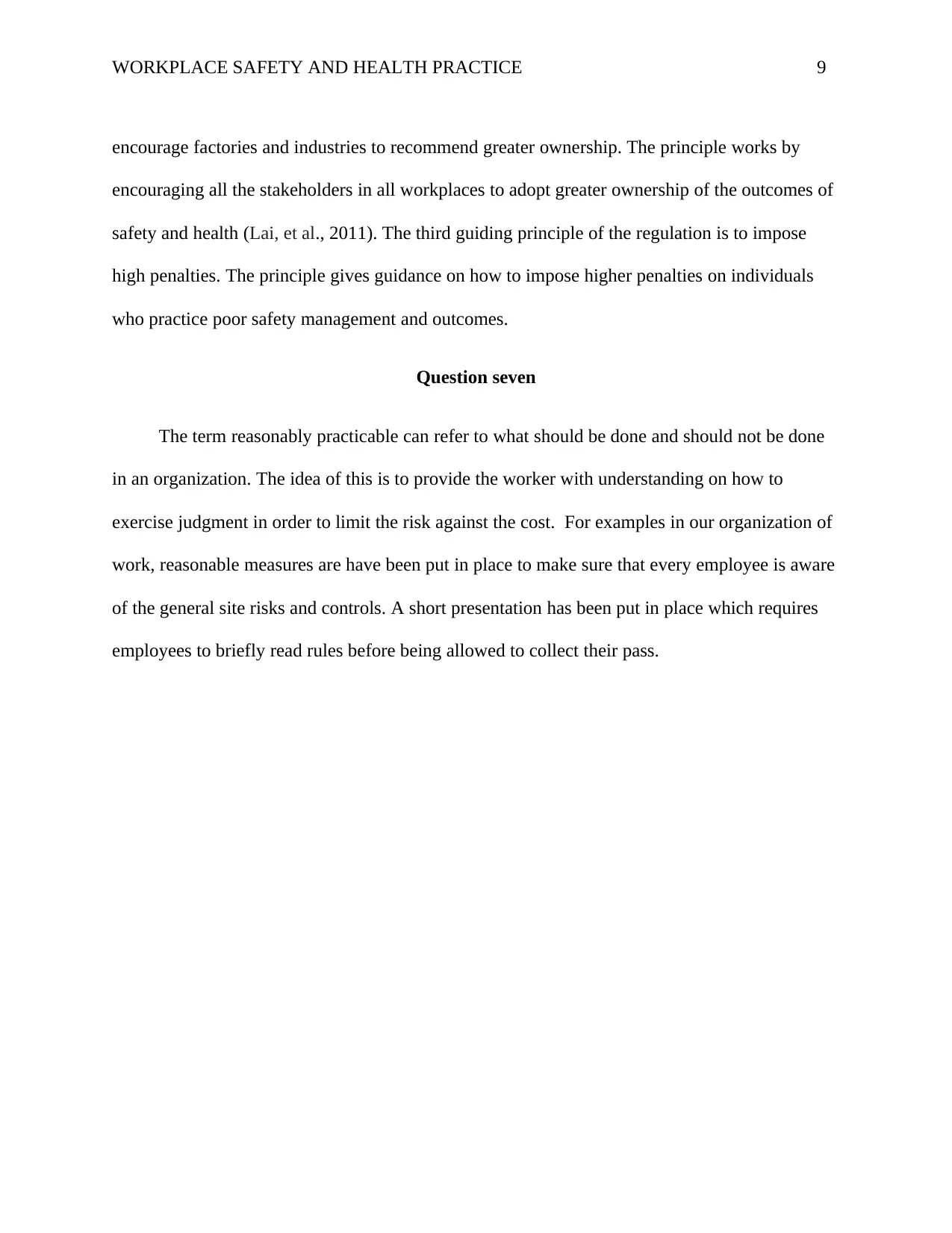
WORKPLACE SAFETY AND HEALTH PRACTICE 9
encourage factories and industries to recommend greater ownership. The principle works by
encouraging all the stakeholders in all workplaces to adopt greater ownership of the outcomes of
safety and health (Lai, et al., 2011). The third guiding principle of the regulation is to impose
high penalties. The principle gives guidance on how to impose higher penalties on individuals
who practice poor safety management and outcomes.
Question seven
The term reasonably practicable can refer to what should be done and should not be done
in an organization. The idea of this is to provide the worker with understanding on how to
exercise judgment in order to limit the risk against the cost. For examples in our organization of
work, reasonable measures are have been put in place to make sure that every employee is aware
of the general site risks and controls. A short presentation has been put in place which requires
employees to briefly read rules before being allowed to collect their pass.
encourage factories and industries to recommend greater ownership. The principle works by
encouraging all the stakeholders in all workplaces to adopt greater ownership of the outcomes of
safety and health (Lai, et al., 2011). The third guiding principle of the regulation is to impose
high penalties. The principle gives guidance on how to impose higher penalties on individuals
who practice poor safety management and outcomes.
Question seven
The term reasonably practicable can refer to what should be done and should not be done
in an organization. The idea of this is to provide the worker with understanding on how to
exercise judgment in order to limit the risk against the cost. For examples in our organization of
work, reasonable measures are have been put in place to make sure that every employee is aware
of the general site risks and controls. A short presentation has been put in place which requires
employees to briefly read rules before being allowed to collect their pass.
⊘ This is a preview!⊘
Do you want full access?
Subscribe today to unlock all pages.

Trusted by 1+ million students worldwide
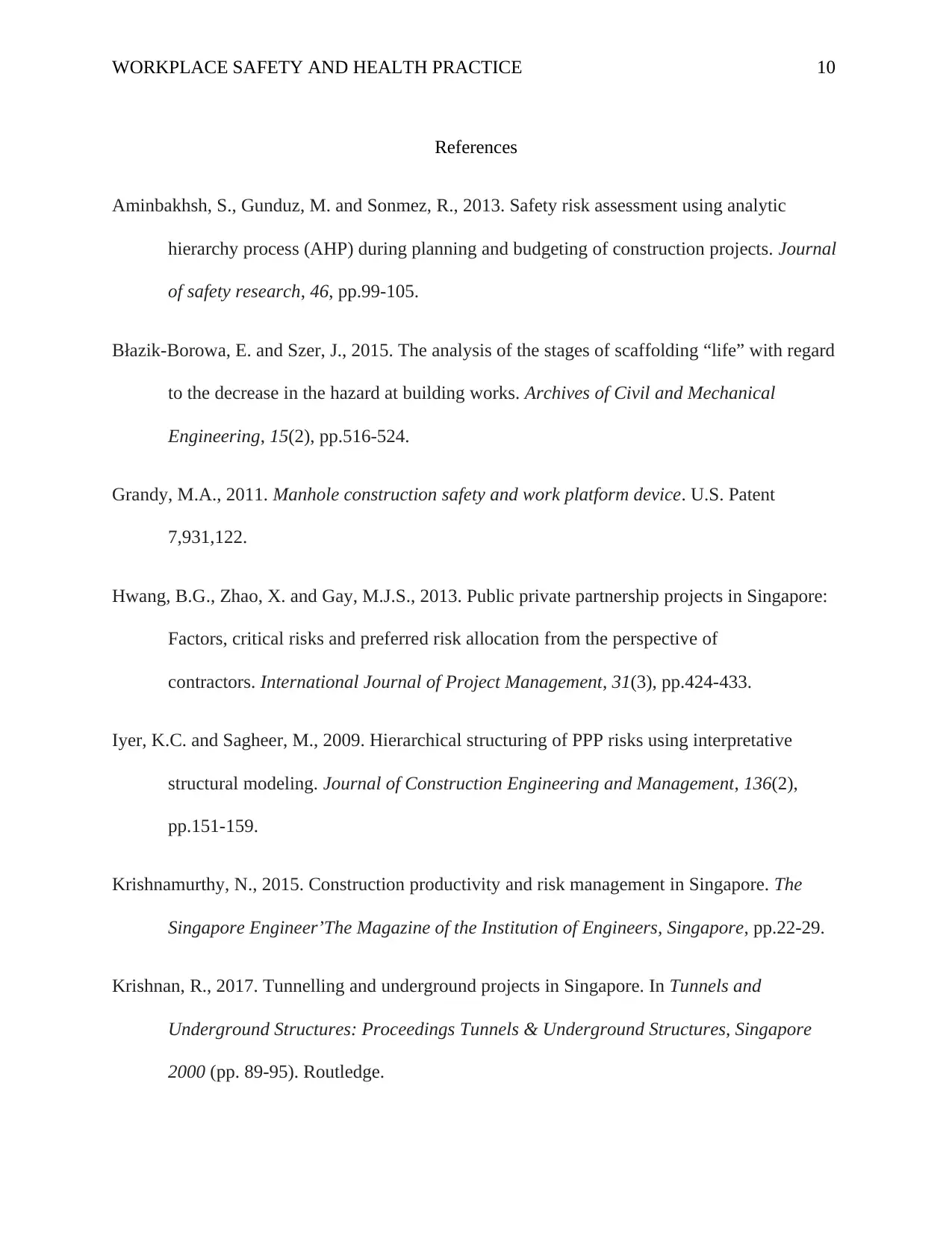
WORKPLACE SAFETY AND HEALTH PRACTICE 10
References
Aminbakhsh, S., Gunduz, M. and Sonmez, R., 2013. Safety risk assessment using analytic
hierarchy process (AHP) during planning and budgeting of construction projects. Journal
of safety research, 46, pp.99-105.
Błazik-Borowa, E. and Szer, J., 2015. The analysis of the stages of scaffolding “life” with regard
to the decrease in the hazard at building works. Archives of Civil and Mechanical
Engineering, 15(2), pp.516-524.
Grandy, M.A., 2011. Manhole construction safety and work platform device. U.S. Patent
7,931,122.
Hwang, B.G., Zhao, X. and Gay, M.J.S., 2013. Public private partnership projects in Singapore:
Factors, critical risks and preferred risk allocation from the perspective of
contractors. International Journal of Project Management, 31(3), pp.424-433.
Iyer, K.C. and Sagheer, M., 2009. Hierarchical structuring of PPP risks using interpretative
structural modeling. Journal of Construction Engineering and Management, 136(2),
pp.151-159.
Krishnamurthy, N., 2015. Construction productivity and risk management in Singapore. The
Singapore Engineer’The Magazine of the Institution of Engineers, Singapore, pp.22-29.
Krishnan, R., 2017. Tunnelling and underground projects in Singapore. In Tunnels and
Underground Structures: Proceedings Tunnels & Underground Structures, Singapore
2000 (pp. 89-95). Routledge.
References
Aminbakhsh, S., Gunduz, M. and Sonmez, R., 2013. Safety risk assessment using analytic
hierarchy process (AHP) during planning and budgeting of construction projects. Journal
of safety research, 46, pp.99-105.
Błazik-Borowa, E. and Szer, J., 2015. The analysis of the stages of scaffolding “life” with regard
to the decrease in the hazard at building works. Archives of Civil and Mechanical
Engineering, 15(2), pp.516-524.
Grandy, M.A., 2011. Manhole construction safety and work platform device. U.S. Patent
7,931,122.
Hwang, B.G., Zhao, X. and Gay, M.J.S., 2013. Public private partnership projects in Singapore:
Factors, critical risks and preferred risk allocation from the perspective of
contractors. International Journal of Project Management, 31(3), pp.424-433.
Iyer, K.C. and Sagheer, M., 2009. Hierarchical structuring of PPP risks using interpretative
structural modeling. Journal of Construction Engineering and Management, 136(2),
pp.151-159.
Krishnamurthy, N., 2015. Construction productivity and risk management in Singapore. The
Singapore Engineer’The Magazine of the Institution of Engineers, Singapore, pp.22-29.
Krishnan, R., 2017. Tunnelling and underground projects in Singapore. In Tunnels and
Underground Structures: Proceedings Tunnels & Underground Structures, Singapore
2000 (pp. 89-95). Routledge.
Paraphrase This Document
Need a fresh take? Get an instant paraphrase of this document with our AI Paraphraser
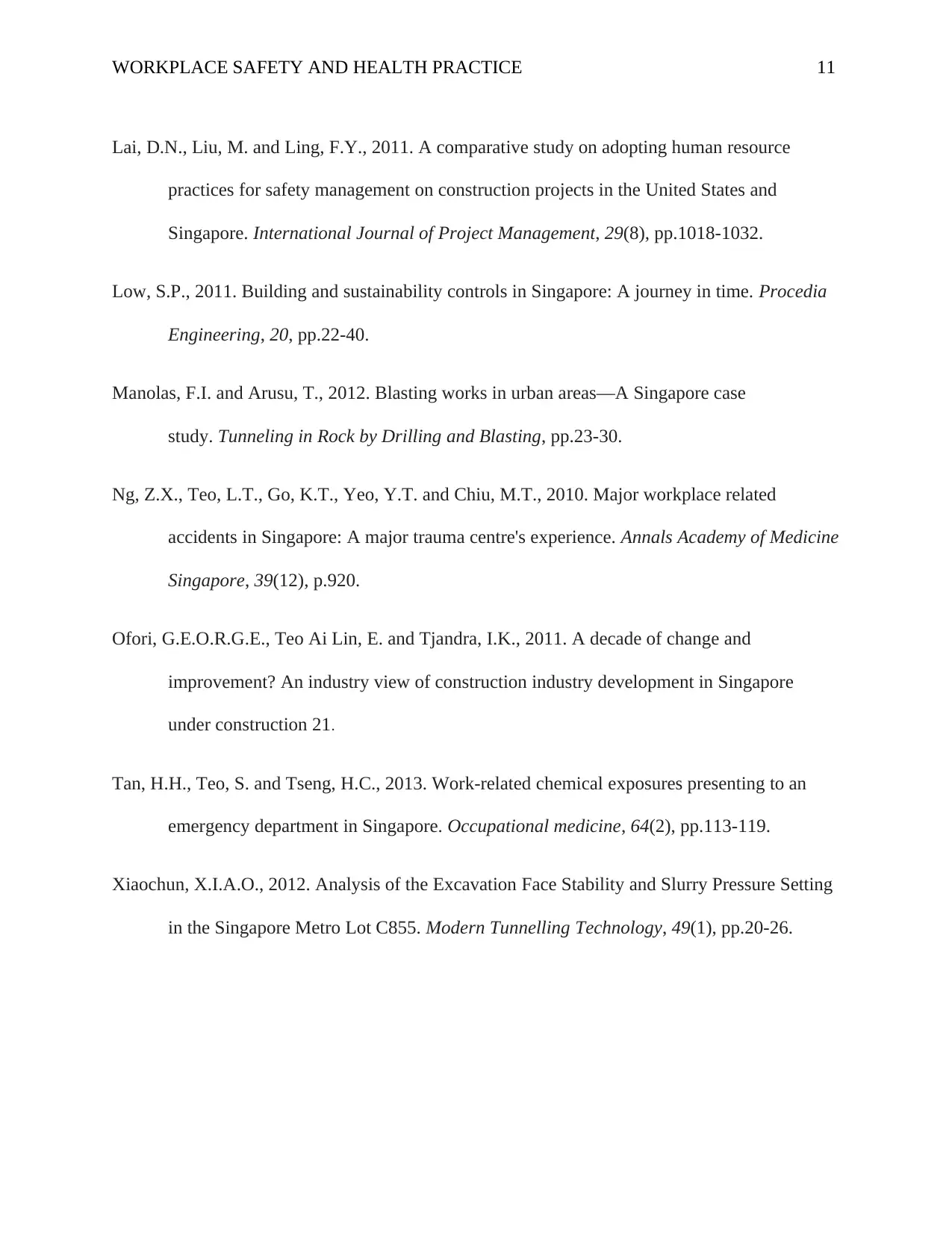
WORKPLACE SAFETY AND HEALTH PRACTICE 11
Lai, D.N., Liu, M. and Ling, F.Y., 2011. A comparative study on adopting human resource
practices for safety management on construction projects in the United States and
Singapore. International Journal of Project Management, 29(8), pp.1018-1032.
Low, S.P., 2011. Building and sustainability controls in Singapore: A journey in time. Procedia
Engineering, 20, pp.22-40.
Manolas, F.I. and Arusu, T., 2012. Blasting works in urban areas—A Singapore case
study. Tunneling in Rock by Drilling and Blasting, pp.23-30.
Ng, Z.X., Teo, L.T., Go, K.T., Yeo, Y.T. and Chiu, M.T., 2010. Major workplace related
accidents in Singapore: A major trauma centre's experience. Annals Academy of Medicine
Singapore, 39(12), p.920.
Ofori, G.E.O.R.G.E., Teo Ai Lin, E. and Tjandra, I.K., 2011. A decade of change and
improvement? An industry view of construction industry development in Singapore
under construction 21.
Tan, H.H., Teo, S. and Tseng, H.C., 2013. Work-related chemical exposures presenting to an
emergency department in Singapore. Occupational medicine, 64(2), pp.113-119.
Xiaochun, X.I.A.O., 2012. Analysis of the Excavation Face Stability and Slurry Pressure Setting
in the Singapore Metro Lot C855. Modern Tunnelling Technology, 49(1), pp.20-26.
Lai, D.N., Liu, M. and Ling, F.Y., 2011. A comparative study on adopting human resource
practices for safety management on construction projects in the United States and
Singapore. International Journal of Project Management, 29(8), pp.1018-1032.
Low, S.P., 2011. Building and sustainability controls in Singapore: A journey in time. Procedia
Engineering, 20, pp.22-40.
Manolas, F.I. and Arusu, T., 2012. Blasting works in urban areas—A Singapore case
study. Tunneling in Rock by Drilling and Blasting, pp.23-30.
Ng, Z.X., Teo, L.T., Go, K.T., Yeo, Y.T. and Chiu, M.T., 2010. Major workplace related
accidents in Singapore: A major trauma centre's experience. Annals Academy of Medicine
Singapore, 39(12), p.920.
Ofori, G.E.O.R.G.E., Teo Ai Lin, E. and Tjandra, I.K., 2011. A decade of change and
improvement? An industry view of construction industry development in Singapore
under construction 21.
Tan, H.H., Teo, S. and Tseng, H.C., 2013. Work-related chemical exposures presenting to an
emergency department in Singapore. Occupational medicine, 64(2), pp.113-119.
Xiaochun, X.I.A.O., 2012. Analysis of the Excavation Face Stability and Slurry Pressure Setting
in the Singapore Metro Lot C855. Modern Tunnelling Technology, 49(1), pp.20-26.
1 out of 11
Related Documents
Your All-in-One AI-Powered Toolkit for Academic Success.
+13062052269
info@desklib.com
Available 24*7 on WhatsApp / Email
![[object Object]](/_next/static/media/star-bottom.7253800d.svg)
Unlock your academic potential
Copyright © 2020–2025 A2Z Services. All Rights Reserved. Developed and managed by ZUCOL.




